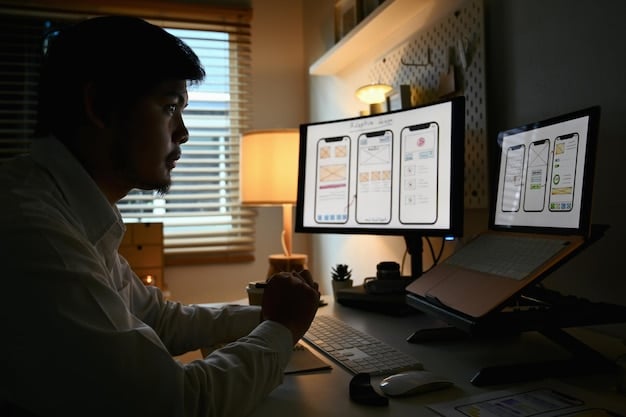Updated for 2025: Tech Solutions for Stress Management & Mental Health

Updated for 2025: How to Use Technology to Manage Stress and Improve Mental Health explores innovative tech solutions like mindfulness apps, wearable sensors, and telehealth services that can help individuals proactively manage stress and enhance their overall mental well-being in the digital age.
In the rapidly evolving landscape of 2025, technology offers unprecedented opportunities to manage stress and improve mental health. From personalized apps to advanced wearable devices, understanding how to leverage these tools is crucial for maintaining well-being. Let’s explore how technology can be your ally in navigating the stresses of modern life, providing support and strategies for a healthier, more balanced mind.
Embracing Technology for Stress Relief
Technology has become an integral part of our daily routines, offering numerous tools that can be tailored to manage stress effectively. In 2025, the integration of digital solutions into mental health care is more seamless than ever, providing options that are both accessible and personalized. By understanding and utilizing these resources, individuals can take proactive steps toward enhancing their mental well-being.
Mindfulness and Meditation Apps
Mindfulness and meditation apps have revolutionized the way people approach mental health. These platforms offer guided meditations, breathing exercises, and relaxation techniques accessible anytime, anywhere. Key features often include personalized programs, progress tracking, and integration with wearable devices for biofeedback.
- Headspace: Provides guided meditations for stress, anxiety, and sleep issues.
- Calm: Offers sleep stories, relaxing music, and daily mindfulness exercises.
- Insight Timer: Features a vast library of free meditations and courses led by expert teachers.
These apps not only provide immediate relief from stress but also cultivate long-term mental resilience. Regular use can lead to improved focus, reduced anxiety, and a greater sense of overall well-being.

Wearable Technology and Biofeedback
Wearable technology, such as smartwatches and fitness trackers, offer real-time insights into your body’s stress responses. These devices monitor physiological indicators like heart rate, sleep patterns, and activity levels, providing valuable data for managing stress effectively.
Biofeedback is a technique that uses these physiological indicators to help individuals gain awareness and control over their bodily functions. By understanding how your body responds to stress, you can learn to implement relaxation techniques more effectively.
In conclusion, technology offers a wide array of tools to help manage stress, from mindfulness and meditation apps to wearable devices that provide real-time biofeedback. These resources empower individuals to proactively address their mental health, fostering resilience and overall well-being in the digital age.
Telehealth: Mental Health Support at Your Fingertips
Telehealth has emerged as a vital resource for accessing mental health support remotely, offering convenience and flexibility that traditional therapy sessions often lack. This innovative approach utilizes video conferencing, phone calls, and messaging apps to connect individuals with licensed therapists and counselors, breaking down barriers such as geographical limitations and scheduling challenges.
Telehealth platforms provide a wide range of services, including individual therapy, group counseling, and psychiatric evaluations, all accessible from the comfort of your own home. This accessibility is particularly beneficial for those living in rural areas or individuals with mobility issues, ensuring that quality mental health care is available to everyone.
Advantages of Telehealth
- Accessibility: Telehealth eliminates geographical barriers, making mental health support available to individuals in remote areas or those with limited mobility.
- Convenience: With flexible scheduling options and the ability to attend sessions from home, telehealth fits seamlessly into busy lifestyles.
- Affordability: Telehealth services are often more affordable than traditional therapy, reducing financial barriers to mental health care.
Additionally, telehealth offers a level of privacy that some individuals may find more comfortable than in-person sessions. The ability to connect with a therapist from a familiar environment can help reduce anxiety and promote a more open and honest dialogue.
Choosing the Right Telehealth Platform
Selecting the right telehealth platform is crucial for a positive and effective experience. Consider the following factors when making your choice:
- Credentialed Therapists: Ensure that the platform employs licensed and experienced mental health professionals.
- Security and Privacy: Verify that the platform uses secure encryption and adheres to HIPAA regulations to protect your personal information.
- User-Friendly Interface: Choose a platform with an intuitive and easy-to-navigate interface.
Telehealth is a transformative tool in modern mental health care, offering accessible, convenient, and affordable support to individuals seeking to manage stress and improve their overall well-being. By embracing this technology, individuals can take proactive steps toward a healthier and more balanced life, with the help of qualified professionals at their fingertips.
Digital Stress-Reduction Tools for Work
The modern workplace is often a hotbed of stress, with long hours, tight deadlines, and constant connectivity contributing to burnout and mental strain. Fortunately, technology offers a range of digital tools that can help mitigate these stressors, promoting a healthier and more productive work environment.
Time Management and Productivity Apps
Effective time management is crucial for reducing workplace stress. Many apps are designed to help you prioritize tasks, set deadlines, and track your progress, ensuring that you stay on top of your workload without feeling overwhelmed.
- Trello: A visual project management tool that allows you to create boards, lists, and cards to organize tasks and collaborate with team members.
- Asana: A comprehensive project management platform that helps teams plan, organize, and execute projects efficiently.
- Todoist: A task management app that allows you to create to-do lists, set reminders, and track your productivity.
By using these tools, you can gain a clearer understanding of your workload and allocate your time more effectively, reducing feelings of being overwhelmed and increasing your sense of control.

Communication and Collaboration Platforms
Effective communication and collaboration are essential for a positive work environment. However, poorly managed communication channels can contribute to stress and confusion. Platforms like Slack and Microsoft Teams offer organized and streamlined communication, helping teams stay connected without feeling bombarded by emails and notifications.
These platforms also facilitate real-time collaboration, allowing team members to work together on documents, share ideas, and provide feedback quickly and efficiently. This reduces misunderstandings and promotes a sense of teamwork, fostering a more supportive and less stressful work environment.
In conclusion, digital stress-reduction tools offer a practical and effective way to manage workplace stress, from time management and productivity apps to communication and collaboration platforms. By integrating these tools into your daily routine, you can create a more organized, efficient, and less stressful work environment, promoting both your mental well-being and your professional success.
The Role of AI in Personalized Mental Healthcare
Artificial intelligence (AI) is rapidly transforming the landscape of mental healthcare, offering personalized solutions that cater to individual needs and preferences. In 2025, AI-powered tools are increasingly being used to diagnose, treat, and manage mental health conditions, providing a level of precision and customization that was previously unattainable.
AI-Powered Chatbots and Virtual Assistants
AI-powered chatbots and virtual assistants offer immediate and accessible support for individuals experiencing stress, anxiety, and other mental health challenges. These tools can provide instant access to coping strategies, relaxation techniques, and educational resources, empowering individuals to manage their symptoms in real-time.
Additionally, AI chatbots can monitor mood patterns, track symptoms, and provide personalized feedback, helping individuals gain a deeper understanding of their mental health and identify triggers for stress and anxiety.
Predictive Analytics and Early Intervention
AI algorithms can analyze vast amounts of data to identify individuals at risk of developing mental health conditions. By identifying early warning signs, healthcare providers can intervene proactively, providing timely support and preventing more severe symptoms from developing.
Predictive analytics can also be used to personalize treatment plans, tailoring interventions to individual needs and preferences. This results in more effective and efficient care, improving outcomes and reducing the burden of mental health conditions.
The role of AI in personalized mental healthcare is continually evolving, offering a promising future for individuals seeking to manage stress and improve their overall well-being. By leveraging the power of AI, healthcare providers can deliver more effective, efficient, and personalized care, empowering individuals to live healthier and more fulfilling lives.
Setting Boundaries with Technology: Digital Detox
While technology offers numerous tools for managing stress and improving mental health, it can also contribute to feelings of overwhelm and anxiety. Constant connectivity and the pressure to be always available can lead to burnout and a diminished sense of well-being. Setting boundaries with technology is essential for maintaining a healthy balance and protecting your mental health.
Scheduling Digital Detox Periods
One of the most effective ways to set boundaries with technology is to schedule regular digital detox periods. This involves intentionally disconnecting from all digital devices for a set amount of time, allowing yourself to fully relax and recharge.
Digital detox periods can range from a few hours to an entire weekend, depending on your needs and preferences. During this time, engage in activities that you enjoy, such as reading, spending time in nature, or connecting with loved ones.
Creating Tech-Free Zones
Another helpful strategy is to create tech-free zones in your home. Designate certain areas, such as your bedroom or dining room, as spaces where digital devices are not allowed. This allows you to create a sanctuary where you can fully disconnect and focus on relaxation and rejuvenation.
By setting boundaries with technology and incorporating regular digital detox periods into your routine, you can regain control over your digital habits and protect your mental health from the negative effects of constant connectivity. This allows you to enjoy the benefits of technology without sacrificing your well-being.
Future Trends in Tech-Enabled Stress Management
The future of tech-enabled stress management is bright, with ongoing advancements in artificial intelligence, virtual reality, and wearable technology paving the way for even more personalized and effective solutions. As technology continues to evolve, we can expect to see even more innovative tools that empower individuals to manage stress and improve their mental health.
Virtual Reality (VR) for Relaxation and Therapy
Virtual reality (VR) is emerging as a powerful tool for relaxation and therapy, offering immersive experiences that can transport individuals to calming and therapeutic environments. VR can be used to simulate peaceful landscapes, guided meditations, and interactive exercises, helping individuals reduce stress and improve their mental well-being.
Additionally, VR can be used in therapy to treat phobias, anxiety disorders, and PTSD, providing a safe and controlled environment for individuals to confront their fears and develop coping strategies.
Integration of AI and Wearable Technology
The integration of AI and wearable technology is poised to revolutionize personalized stress management. AI algorithms can analyze data from wearable devices to identify patterns and predict stress levels, providing timely interventions and personalized recommendations. This includes suggesting relaxation techniques, adjusting sleep schedules, and recommending changes to diet and exercise routines.
These future trends in tech-enabled stress management offer a glimpse into the exciting possibilities that lie ahead, promising a future where technology plays an even greater role in promoting mental health and well-being.
| Key Point | Brief Description |
|---|---|
| 🧘 Mindfulness Apps | Apps like Headspace and Calm offer guided meditations for stress relief. |
| ⌚ Wearable Tech | Smartwatches track heart rate and sleep patterns to monitor stress levels. |
| 💻 Telehealth Services | Access therapy remotely via video conferencing and messaging apps. |
| 🤖 AI-Powered Tools | AI chatbots offer instant support and personalized mental health guidance. |
Frequently Asked Questions
▼
Mindfulness apps provide guided meditations and relaxation techniques that help reduce anxiety and improve focus by promoting a sense of calm and awareness.
▼
Wearable devices track physiological indicators like heart rate and sleep patterns, offering real-time insights into your body’s stress responses for better management.
▼
Telehealth can be as effective as in-person therapy for many mental health conditions, offering convenient and accessible support from licensed professionals.
▼
AI algorithms analyze data to provide personalized recommendations, track symptoms, and identify triggers for stress and anxiety, enhancing treatment effectiveness.
▼
A digital detox involves intentionally disconnecting from digital devices to reduce stress and promote mental well-being by fostering relaxation and rejuvenation.
Conclusion
As we move further into 2025, technology continues to offer innovative solutions for managing stress and improving mental health. By embracing these tools responsibly and setting healthy boundaries, we can harness the power of technology to enhance our well-being and live more balanced lives.





